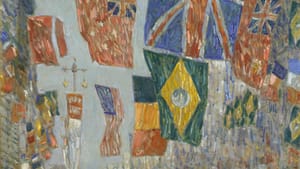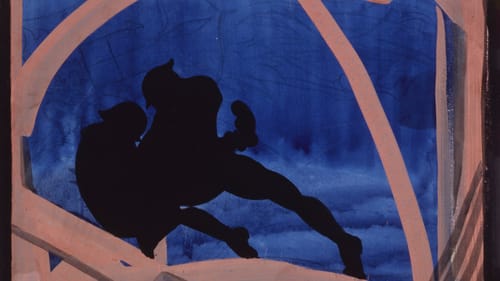Stay in the Loop
BSR publishes on a weekly schedule, with an email newsletter every Wednesday and Thursday morning. There’s no paywall, and subscribing is always free.
The struggle is real
PAFA presents World War I and American Art (second review)

I had originally planned to go see the new Pennsylvania Academy of the Fine Arts (PAFA) show, World War I and American Art, on November 9, but my head and my heart were both too full of the election sucker punch to give the art the attention it deserves. So it was a few days later — after the nightly protests and marches had begun, but before Facebook had lit up with local groups forming and lawmakers’s phone numbers being exchanged — that I made it to North Broad. As I contemplated the world-changing events of a century ago, I continued to meditate on the world-changing election just passed.
When the winners write their histories, they give short shrift not only to the perspectives and successes of their opponents, they generally omit the conflicts and divisions on their own side, lest the narrative of inevitability be muddied. The PAFA show, in contrast, looks carefully at both sides of the heated debate over whether or not the United States should enter a European war.
Before . . .
The exhibition’s opening room presents the debate through the work of two fine artists. Childe Hassam’s flag paintings — he made about 30, a half dozen or so are on view here — were created in support of the Allies. In contrast, the modernist works Marsden Hartley was painting in Berlin in 1914 and 1915 made extensive use of the Prussian martial imagery surrounding him. The works shouldn’t be interpreted as propaganda in the same way that Hassam’s was, though, and despite the iconography, they certainly shouldn’t be seen as Axis propaganda. Attracted to visuals as graphic elements, he was also emotionally involved with the subject of his “Portrait of a German Officer,” Karl von Freyburg. His attitude changed after Freyburg’s death in the war, when war became not "a romantic but a real reality."
The visual impact of the two men’s work is as markedly different as their respective sources of inspiration. Hassam’s works — scenic, pastel in tone, Impressionistic in influence — look backward both culturally and in art historical terms. Hartley’s — with their collagelike compositions, muted primary colors, and solidly Modernist approach — look forward to the chaos of the dawning century.
Other artists tackled the war, pro and con, more directly and explicitly. Many graphic artists and illustrators supported the war with propaganda posters. The exhibit includes many, including James Montgomery Flagg’s famous “I Want You” Uncle Sam image and Howard Chandler Christy’s “Gee I Wish I Were a Man” poster. (Full disclosure: a reproduction of the latter hung in the dining room of my grad school apartment.) Less familiar works illustrate (literally) how issues around gender, race and class came into play in support for the war.
Antiwar propaganda is shown as well, plus works pro and con by George Bellows, who changed positions during the war. He was one of the artists seen as being possibly susceptible to enemy influence, whom the government therefore kept tabs on. Another artist viewed with suspicion by the establishment was Georgia O’Keeffe, represented in this show by a painting (of a flag) done after visiting her brother on a Texas army base.
. . . And after

Having explored the impact of artists on the war effort, the second half of the exhibition looks at the war’s impact on artists. This effect was felt most directly by combatants, as shown in a series of watercolors by Claggett Wilson, who fought in the Battle of Belleau Wood. His war paintings were exhibited in 1920 but have since been mostly forgotten. These strong images, which communicate the experience of soldiers in the trenches, are worth the significant amount of wall space given to them here.
Photographer Edward Steichen also served, though his perspective on the war was elevated: He was chief of the American Expeditionary Force’s aerial photography section. (Several of the photographs he took during bombing runs are shown.) Steichen became a Modernist as a result of his war experiences, eschewing his prewar impressionism for the crisp, precise images that made him one of the 20th century’s most important American photographers.
Non-combatants were inspired as well. Duchamp submitted his famous “Fountain” to the annual exhibition of the Society of Independent Artists in 1917, from which was equally famously rejected. The detail I’d never heard was that the submission came two days after the United States, his adopted home, entered the war. And Steiglitz’s famous photo of the urinal-turned-sculpture? The backdrop is one of Marsden Hartley’s Prussian-themed works.
The show, curated by Robert Cozzolino, Anne Knutson, and David Lubin, is well chosen and well presented, with informative signage throughout. And it’s well worth contemplating, especially as we enter another period of cultural and political upheaval. Let’s hope the artists among us do as much honor to the struggle we’re embarking on.
What, When, Where
World War I and American Art. Through April 9, 2017 at the Pennsylvania Academy of the Fine Arts, Samuel M.V. Hamilton Building, 128 N. Broad Street, Philadelphia. (215) 972-7600 or pafa.org.
Sign up for our newsletter
All of the week's new articles, all in one place. Sign up for the free weekly BSR newsletters, and don't miss a conversation.

 Judy Weightman
Judy Weightman